Reading: Time Value of Money
Time
Value of Money
•The
time value of money (TVM) is the idea that money available at the present time
is worth more than the same amount in the future due to its potential earning
capacity. This core principle of finance holds that, provided money can earn
interest, any amount of money is worth more the sooner it is received. TVM is
also referred to as present discounted value.
TVM formula takes into account the following variables:
•FV
= Future value of money
•PV
= Present value of money
•i =
interest rate
•n
= number of compounding periods per year
•t
= number of years
•Based
on these variables, the formula for TVM is:
•FV
= PV x (1 + (i /
n)) ^ (n x t)
What
is Simple Interest?
•Interest
– A rental fee to borrow money
•Simple
interest is when the interest received or paid is based solely on the amount of
money that was initially invested. Therefore, the interest earned each period
or year will be the same.
•Simple
interest formula
Initial investment x (1 + (interest rate x number of periods))
Initial investment x (1 + (interest rate x number of periods))
Compound
Interest


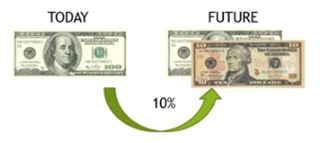

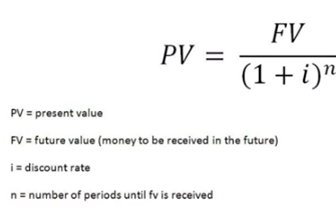
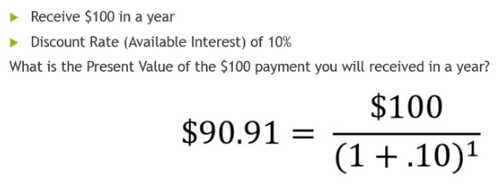
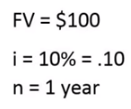
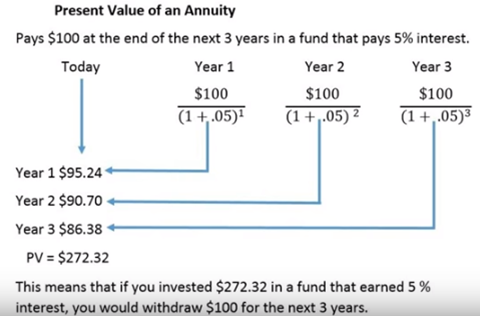
•Compound
interest is much different than simple interest. Compound interest is the kind
of interest you would like to receive in an investment but definitely would not
want to pay. Why? Because the interest rate is based on the balance of the
investment when it is calculated, not the initial investment. What this means
is that interest is being earned on both the investment, and the interest
earned from previous periods.
Compound
Interest


161.05 = $100 x (1+.1) ^5
Future
Value
•Future
value is what a dollar today will be worth in the future. This is because of
the interest that dollar can earn over time, therefore making it more valuable
in the future.

The
Future Value Formula

Future
Value of a $1,000 Corporate Bond
Yield = 10%
Number of Periods = 10
FV = $1,000 x (1 + .1) ^10
FV = $2593.74
Yield = 10%
Number of Periods = 10
FV = $1,000 x (1 + .1) ^10
FV = $2593.74
What
is an Annuity?
•An
annuity is a series of equal payments that are either paid to you of paid from
you. Annuities can be Cash Flow’s paid such as monthly rent payments, car
payments, or they can be money received such as Semi-Annual coupon payments
from a Bond. Just remember, for a series of cash flows to be considered an
annuity, the cash flows need to be equal.
•Annuity
Due: An annuity due is when payment is made at the beginning of the payment
period. Rent for example where you are usually required to pay rent in advance
at the first of the month.
•Ordinary
Annuity: An ordinary annuity is a payment that is paid or received at the end
of the period. An example of an ordinary annuity would be a coupon payment made
from bonds. Usually bonds will make semi-annual coupon payments at the end of
every six months
Present
Value
•Present
value (PV) is the current worth of a future sum of money or stream of cash
flows given a specified rate of return. Future cash flows are discounted at the
discount rate, and the higher the discount rate, the lower the present value of
the future cash flows. Determining the appropriate discount rate is the key to
properly valuing future cash flows, whether they be earnings or
obligations.
•PV
is also referred to as the "discounted value." The basis is that
receiving $1,000 now is worth more than $1,000 five years from now, because if
you got the money now, you could invest it and receive an additional return
over the five years.
•
•The
money today is worth more than the same money tomorrow because the passage of
time has financial value attached to it and rewards or costs are demanded for
owning or using today's money. Future value can relate to future investment
cash inflows from investing today's money or future payment outflows from
borrowing today's money.
•Present
value provides a basis for assessing the fairness of any future financial
benefits or liabilities. For example, a future cash rebate discounted to
present value may or may not be worth having a potentially higher purchase
price. The same financial calculation applies to 0% financing when buying a
car. Paying some interest instead on a lower sticker price may work out better
for the buyer than paying zero interest on a higher sticker price. Paying
mortgage points now in exchange for lower mortgage payments later makes sense
only if the present value of the future mortgage savings is greater than the
mortgage points paid today.
Present
Value Formula



Present
Value of a Cash Flow Series

Last modified: Tuesday, August 14, 2018, 8:41 AM
